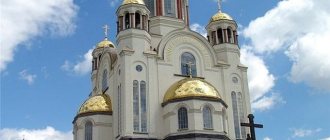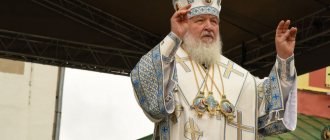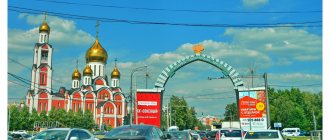The Vologda Metropolis is a fairly ancient metropolis of the Russian Orthodox Church. It consists of three dioceses: Vologda and Kirillov, Cherepovets and Belozersk, Veliky Ustyug and Totem dioceses.
Trinity Church in the city of Totma, Vologda region, belongs to the Vologda Metropolis
Story
Before the establishment of the Vologda diocese, its northwestern region was part of the Novgorod diocese, and the southern and eastern regions were part of the Rostov diocese[1].
In 1492, Archbishop Gennady of Novgorod ceded Vologda to the Perm diocese. By decree of the cathedral in 1589, the department was moved to Vologda and the bishops began to be called Vologda and Velikoperm[1].
In the last decades of the 18th century, the boundaries of the dioceses were brought into line with the boundaries of the provinces. A number of territories of the Vologda diocese, which ended up in the Kostroma, Tver, Novgorod, and Arkhangelsk provinces, were transferred to the corresponding dioceses.
In 1918, classes at the Vologda Theological Seminary, theological school and the diocesan women's school ceased. In 1918-1919, all house churches in Vologda (with the exception of the cross church at the bishop's house) and city monasteries were closed; in most monastery churches, which became parish churches, services were performed until the end of the 20s.
In 1921-1922, the Vologda clergy actively participated in raising funds for the benefit of the starving people in the Volga region. In 1921, gatherings were held in churches, and in February 1922, two spiritual concerts were held in favor of the starving. However, this did not prevent the authorities from carrying out a massive confiscation of church valuables in the province. From the churches of the Vologda province, 4 pounds 42 spools of gold, 393 pounds 20 pounds of silver, 5 pounds 86 spools of silver with pearls, 5003 precious stones, 4 pounds 21 spools of pearls, 29 pounds 10 spools of pearls in sewing were seized.
On December 16, 1929, the Presidium of the All-Russian Central Executive Committee adopted a resolution “On the regulation of bell ringing in churches,” which actually prohibited it. In Vologda, on December 29, 1929, at a meeting of the Presidium of the Vologda City Council, a resolution was adopted to prohibit the ringing of bells in all churches of the city, and a proposal was also developed to the All-Russian Central Executive Committee with a request to allow the removal of bells from city churches and their transfer to the non-ferrous metallurgy fund.
In 1929-1930 there was an impressive wave of church closures.
In 1937, the Vologda region was formed - from 1939/1940 until the fall of 1942, services on its territory were performed in a single church - the lower church of the Bogorodskoe cemetery of Vologda. In 1944, the diocesan boundaries were brought into line with the regional ones. By 1948, 17 churches operated on the territory of the diocese.
On October 23, 2014, by the decision of the Holy Synod, two new ones were separated from the Vologda diocese: the Cherepovets and Belozersk diocese and the Veliky Ustyug and Totem diocese[2].
The Vologda diocese includes 10 deaneries, there are 2 cathedrals
The Vologda diocese includes such districts as Vozhegodsky, Verkhovazhsky, Kirillovsky, Gryazovets, Sokolsky, Kharovsky and others.
The diocese also includes 10 deaneries, which include 105 churches in the region. There are only 2 cathedral churches in the diocese.
Saint Sophia Cathedral
In other words, the Cathedral of Sophia of the Wisdom of God is one of the oldest stone structures on the territory of Vologda. It is also considered one of the largest buildings of the era of Ivan the Terrible. Built in 1568 - 1570 by order of Ivan the Terrible himself. Since 1587, the temple has been considered a cathedral in the Vologda diocese. The cathedral preserves frescoes from the 17th century and an iconostasis from the first half of the 18th century.
St. Sophia Cathedral of the Vologda diocese is one of the largest buildings of the era of Ivan the Terrible
Resurrection Cathedral
Another cathedral in the city of Vologda. It was built in 1772 as a warm temple. Construction took place by order of Archbishop Joseph the Golden. Currently, the cathedral is an architecture of feudal significance.
Resurrection Cathedral of the Vologda diocese - currently architecture of feudal significance
Bishops
- Joasaph I (1558-1570)
- Macarius (1568-1574)
- Varlaam I (1576—1584)
- St. Anthony (October 11, 1585 - October 26, 1587)
- Jonah (Dumin) (June 1588—1603)
- Joasaph II (December 1603 - mentioned May 1609)
- Sylvester (July 1611 - July 11, 1613)
- Nectarius the Greek (June 25, 1613-1616)
- Macarius (February 9, 1617 - July 22, 1619)
- Cornelius (February 6, 1620 - March 17, 1625)
- Nectarius the Greek (May 1625 - June 3, 1626)
- Varlaam II (October 8, 1626 - January 1645)
- St. Marcellus (16 January 1645 – 22 March 1663)
- Simon (23 October 1664 - August 1684)
- Gabriel (Kichigin) (September 7, 1684 - March 30, 1707)
- Joseph (October 17, 1708 - January 18, 1716)
- Pavel (Vasiliev) (January 29, 1716 - November 5, 1725)
- Joachim (March 16 - April 22, 1726)
- Athanasius (Paussius-Kondoidi) (October 9, 1726 - September 17, 1735)
- Ambrose (Yushkevich) (February 2, 1736 - May 29, 1740)
- Pimen (Savelov) (June 29, 1740 - May 26, 1753)
- Serapion (Lyatoshevich) (October 29, 1753 - December 1761)
- Joseph (Zolotov) (December 16, 1761 - December 25, 1774)
- Iriney (Bratanovsky) (April 26, 1775 - April 23, 1796)
- Arseny (Todorsky) (August 15, 1796 - June 15, 1802)
- Anthony (Znamensky) (July 5, 1802 - February 13, 1803)
- Theophylact (Slonetsky) (April 26, 1803 - January 3, 1808)
- Evgeny (Bolkhovitinov) (January 24, 1808 - July 19, 1813)
- Onisifor (Borovik) (February 22, 1814 - November 28, 1827)
- Moses (Bogdanov-Platonov-Antipov) (November 28, 1827 - November 29, 1828)
- Stefan (Romanovsky) (November 24, 1828 - March 1, 1841)
- St. Innocent (Borisov) (March 1 - December 31, 1841)
- Irinarh (Popov) (January 12, 1842 - November 12, 1844)
- Evlampy (Pyatnitsky) (November 22, 1844 - June 15, 1852)
- Feognost (Lebedev) (July 13, 1852 - July 31, 1856)
- Christopher (Emmaus) (July 31, 1856 - June 17, 1866)
- Pavel (Dobrokhotov) (August 21, 1866 - July 7, 1869)
- Palladium (Raev-Pisarev) (July 15, 1869 - June 13, 1873)
- Feodosius (Shapovalenko) (June 13, 1873 - August 22, 1883)
- Israel (Nikulitsky) (October 25, 1883 - April 23, 1894)
- Anthony (Florensov) (April 30, 1894 - June 12, 1895)
- Alexy (Sobolev) (June 12, 1895 - April 21, 1906)
- Nikon (Rozhdestvensky) (April 25, 1906 - May 29, 1912)
- Anthony (Bystrov) (1911) v/u, ep. Velsky
- St. Alexander (Trapitsyn) (May 16, 1912 - March 1921)
- Alexander (Nadezhdin) (March 1921 - November 1922) deviated from Renovationism
- Pavel (Vilkovsky) (August 26 - October 1923) was not at the department
- Pavel (Kratirov) (September 4 - October 22, 1923) v/u
- Sylvester (Bratanovsky) (October 22, 1923-1928) Nikolai (Karaulov) (1925) v/u, bishop. Velsky
- 1940-1944 - the diocese was widowed
The Veliky Ustyug diocese has 3 deaneries and 2 cathedrals
The Veliky Ustyug diocese includes such districts as Velikoustyugsky, Babushkinsky, Nikolsky, Totemsky, Nyuksensky, Tarnogsky and others. The ruling bishop is Bishop Tarasy, who has the title of Veliky Ustyug and Totemsky.
Bishop Tarasy - has the title of Veliky Ustyug and Totemsky
The Diocese of Veliky Ustyug has 3 deaneries. There are two cathedrals in the diocese.
Cathedral of the Nativity of Christ in the city of Totma
The cathedral was built in two stages, like most Totem temples. In the 40s of the 18th century, the lower warm temple was built, and after another 40 years a slender summer church was erected above it.
Cathedral of the Nativity of Christ in the city of Totma, Veliky Ustyug diocese
Unfortunately, the free-standing bell tower has not survived. The lower temple looks rather modest.
Assumption Cathedral in Veliky Ustyug
The cathedral is considered one of the oldest buildings in the city. It is located on the Cathedral Courtyard, in the oldest part of the city. The temple was originally built in 1619, and it was made of stone. But a little later it burned down and was dismantled.
Assumption Cathedral in Veliky Ustyug, Veliky Ustyug diocese. The cathedral is considered one of the oldest buildings in the city. It is located on the Cathedral Courtyard, in the oldest part of the city.
The modern building was built from 1639 to 1658. It was rebuilt many times. This cathedral can be said to reflect the features of a variety of architectural styles.
The main volume of the cathedral is cubic. The cathedral once had four pillars, but after one of the reconstructions in the 18th century, it lost two pillars. On the east of the cathedral there is a bell tower, while one of the towers has a spire, and the other ends simply with a dome.
Since 1682, the cathedral served as a cathedral. Tarasius of Veliky Ustyug and Totemsky very often performs divine liturgies there. The temple also served as a burial place for bishops. Their images are preserved on the walls of the cathedral.
July 21, 2018
Memorial Day of St. Procopius of Ustyug
Bishop Tarasy of Veliky Ustyug and Totemsky led the divine liturgy in the cathedral of the city of Veliky Ustyug.
Monasteries
- Spaso-Prilutsky Dimitriev Monastery (male; Vologda)
- Kirillo-Belozersky Monastery (male; Kirillov)
- Goritsky Resurrection Monastery (women; Goritsy village, Kirillovsky district)
- Holy Trinity Pavlo-Obnorsky Monastery (male; Gryazovets district)
- Spaso-Kamenny Monastery (male, Ustyanskoye rural settlement, Ust-Kubinsky district)
- Ferapontov Belozersky Monastery (male; Ferapontovo village)
- Zaonikievskaya Bogoroditsa-Vladimirskaya Hermitage (female; Luchnikovo village, Vologda district)
- Gorne-Uspensky Monastery (women; Vologda)
- Nilo-Sorskaya Pustyn (male; Pustyn town, Kirillovsky district)
- Rabang Spaso-Preobrazhensky Monastery (male; Sloboda village, Sokolsky district)[3]
inactive
- Korniliev-Komelsky Monastery (male)
- Aleksandro-Korovinskaya hermitage (Gryazovets district)
The Cherepovets diocese contains 13 deaneries, 83 churches and 2 monasteries
Now let's look at the other 2 dioceses that are part of the Vologda Metropolis. The Cherepovets diocese includes such districts as Babaevsky, Kaduysky, Ustyuzhensky, Belozersky, Chagodoshchensky, Vashkinsky and others.
The ruling bishop is Bishop Flavian, who has the title of Cherepovets and Belozersk. The diocese includes 13 deaneries, in which there are 83 churches and 2 monasteries. There are two cathedrals in the Cherepovets diocese.
The ruling bishop is Bishop Flavian, has the title of Cherepovets and Belozersk
Cathedral in the name of Saints Athanasius and Theodosius of Cherepovets
The upper altar of the temple is consecrated in honor of the Feast of the Annunciation of the Most Holy Theotokos, and the lower altar is in honor of Saints Athanasius and Theodosius and the Cherepovets.
Cathedral in the name of Saints Athanasius and Theodosius of Cherepovets, belongs to the Cherepovets diocese
In the lower church, on the ground floor, there is a baptismal font. The funeral service and memorial service are also held in this place. The top one is larger than the bottom one, it looks more solemn. It hosts morning and evening liturgies and prayer services.
Transfiguration Cathedral
The time of construction dates back to 1668. It is a four-pillar temple with five onion domes. The cathedral has preserved a multi-tiered iconostasis from the late 18th century.
Spaso-Preobrazhensky Cathedral of the Cherepovets diocese - date of construction dates back to 1668, currently belongs to the city museum
Divine services were held there until August 1937. During the terror, all the priests were arrested and shot in Leningrad. After the closure of the temple, its interior was maintained in proper condition. Currently the temple belongs to the city museum.
The Vologda Metropolis has an official website where you can find out news and decrees of the Metropolitan
The Vologda Metropolis has its own official website. On it you can find out the latest news from the Vologda diocese, as well as the decrees of the Metropolitan.
Official website of the Vologda Metropolis
Most recently, at the beginning of December 2021, a meeting of the Vologda diocese was held, at which Metropolitan Ignatius told the clergy of the diocese that since the beginning of December, the Nilo-Sora Hermitage has been one of the main monasteries of the Vologda land.
The Pustynsky psychoneurological boarding school was located there for almost 60 years. And it was on December 3 that it closed. Hieromonk Evfimy Ershov was appointed rector of this metochion.
Since December 2021, the Nilo-Sorskaya Hermitage has been one of the main abodes of the Vologda land. Hieromonk Evfimy Ershov was appointed rector of this metochion
In the Vologda Metropolis there are shrines, for example, the relics of St. Martinian and Galaktion of Belozersky, the relics of St. Kirill of Belozersky, and there are also particles of the relics of the Kiev-Pechersk saints, Saints Theodosius and Lawrence of Chernigov, and the Blessed Matrona of Moscow.
The relics of Lawrence of Chernigov, located on the territory of the Vologda Metropolis
Also in the churches there are two revered images of St. Nicholas. You can visit many of these shrines if you come and personally visit these wonderful places.
By leaving a comment, you accept the user agreement




